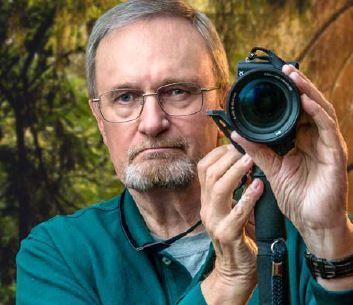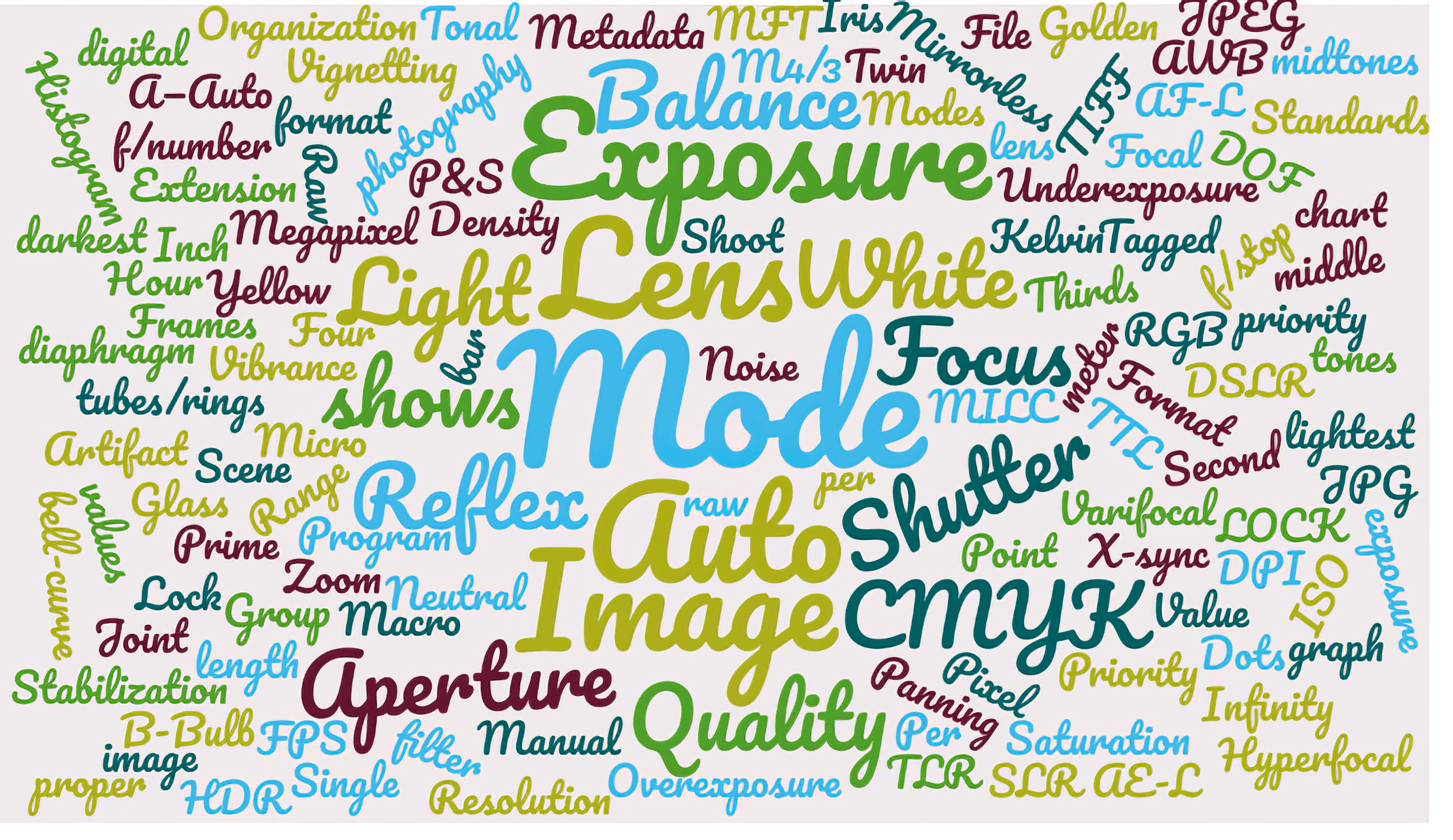Illustration by Charles Haacker
“Hey, Bob, is that your new MILC?”
“Why, yes, yes, it is, Ray. It’s an MFT!”
“Wow, Bob, that’s swell! How’s its AF?”
“Oh golly, Ray, it’s the best. Blows the doors off my old DSLR, plus it’s got in-body IS.”
“Holy cats! Can I hold it?”
“No.”
So, what’d they say? Even if you are a photographer thinking you are reasonably well-versed in the jargon, the lingo, of photography, I bet you missed at least one or two of those abbreviations.
MILC stands for Mirrorless Interchangeable Lens Camera. MFT means Micro Four-Thirds a particular sensor format, sometimes represented as M4/3. AF stand for Auto Focus. DSLR is Digital Single Lens Reflex, but I bet everybody got that one. IS is short for Image Stabilization, which can be in-body, lens, both, or not included.
Sounds like Bob’s got himself a brand-new Olympus OM-D E-M5 III MILC, about $1,500 US, but it is one whale of a camera.
When you are reading about photography, you see terms and abbreviations that “everybody knows” – except you. You’re not alone. Sometimes writers and bloggers seem to make them up on the fly, so hopefully we can help with an alphabetized list of a few* and their meanings.
*There are waaaaay more than a “few,” so I’ve tried for “most relevant.”
When you are reading about photography, you see terms and abbreviations that “everybody knows” – except you. You’re not alone.
Aperture. A device that controls the AMOUNT of light passing through the lens to reach the film/image sensor. It works in conjunction with the SHUTTER that controls the length of TIME that light is allowed to pass through the APERTURE. Together they control EXPOSURE at any given ISO. Apertures are most commonly composed of a set of blades called the IRIS DIAPHRAGM.
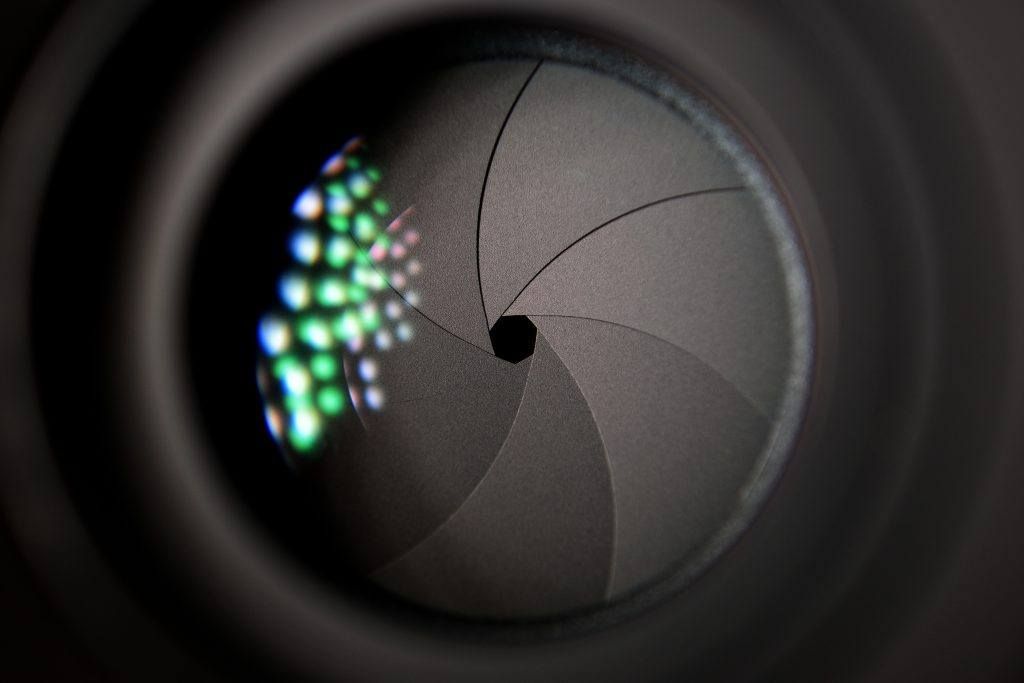
Closeup of an iris diaphragm that makes the aperture adjustable in a camera lens.
Recommended Reading: Want a simple way to learn and master photography on the go? Grab our set of 44 printable Snap Cards for reference when you’re out shooting. They cover camera settings, camera techniques, and so much more. Check it out here.
A. Aperture Priority Automation, abbreviated A or Av, lets you set the desired aperture (f/stop), while the camera chooses the shutter based on its meter reading and the preset ISO.
AE-L. Auto Exposure Lock; allows a meter reading taken from the scene to be locked in, overriding the auto exposure.
AF. Auto Focus. The AF feature automatically focuses on a subject for a sharp image. Many cameras have sophisticated selectable autofocus systems, but also have manual focus for when autofocus doesn’t work well.
AF-L. Auto Focus LOCK; allows the focus to be locked on a specific part of the scene, overriding the autofocus. Autofocus often defaults to the nearest object in the scene instead of your subject.
Artifact. Picture degradation that occurs from image processing, such as the compressing of a JPEG. Visible as banding, haloing (halation), and increased digital “noise.”

Artifacting: This was a “sweep” JPEG panorama from a tiny-sensor P&S. The clouds have no recoverable detail and everywhere that sky meets land there is haloing. Photo by Charles Haacker.
Aspect Ratio. The ratio of a picture’s length to its width. The common 35mm full-frame, 36 x 24mm, has an aspect ratio of 3:2.
A—Auto. Short for Automatic, sometimes signified by a little green camera icon on the selector dial. In full Auto Mode, the camera calculates and adjusts all camera settings for correct exposure, a “pointand-shoot mode.” Most digital cameras have it, including many high-end DSLRs. (See also Program mode.)
AWB. Auto White Balance. “White” light has long been considered to be noon sunlight. “Daylight” films are balanced for it but produce strange colors indoors in artificial light. Digital can be “white balanced” for nearly any light. AWB is a compromise that works fairly well in most light. If you shoot in RAW, white balance can be changed in post-production.
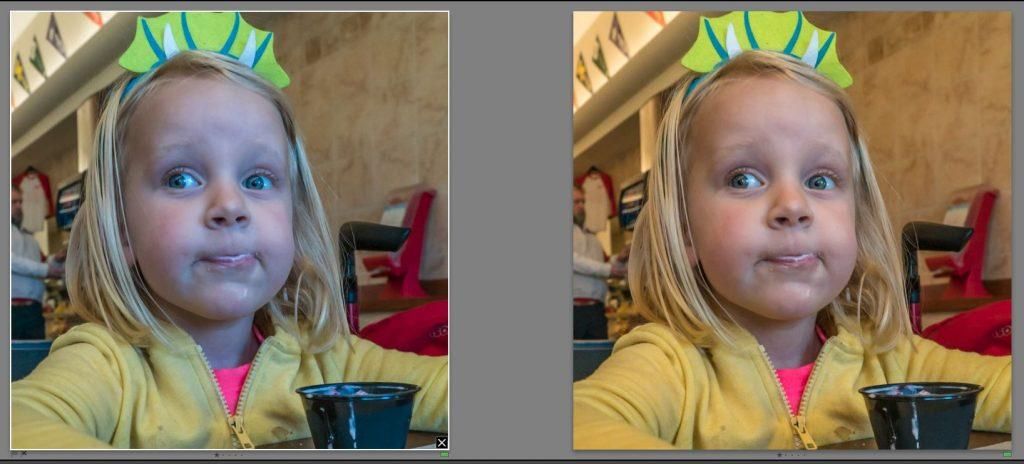
At the ice creamery, my camera’s auto White Balance was misled by the mixed light, including a large window behind me. RAW capture made this easy to correct. Photo by Charles Haacker
Bracketing. Taking three or more exposures on either side of the metered exposure to increase dynamic range.
B. Bulb, a mode for making exposures longer than 30 seconds (the maximum exposure time on many cameras). It takes its name from the old pneumatic bulb shutters on studio cameras.

A 1909 “hand” camera with a Conley Automatic pneumatic shutter. Photo by Greg L
CMYK. Stands for the secondary colors: Cyan, Magenta, Yellow, and Black, the four-color process used in most color reproduction such as posters and magazines. (See also RGB.)
DOF. Depth of Field; the zone of apparent sharp focus before and behind a subject focused upon in a photograph. DOF is affected by the aperture, lens focal length, and the distance focused upon. It can be very shallow or very deep depending on all the affecting factors.
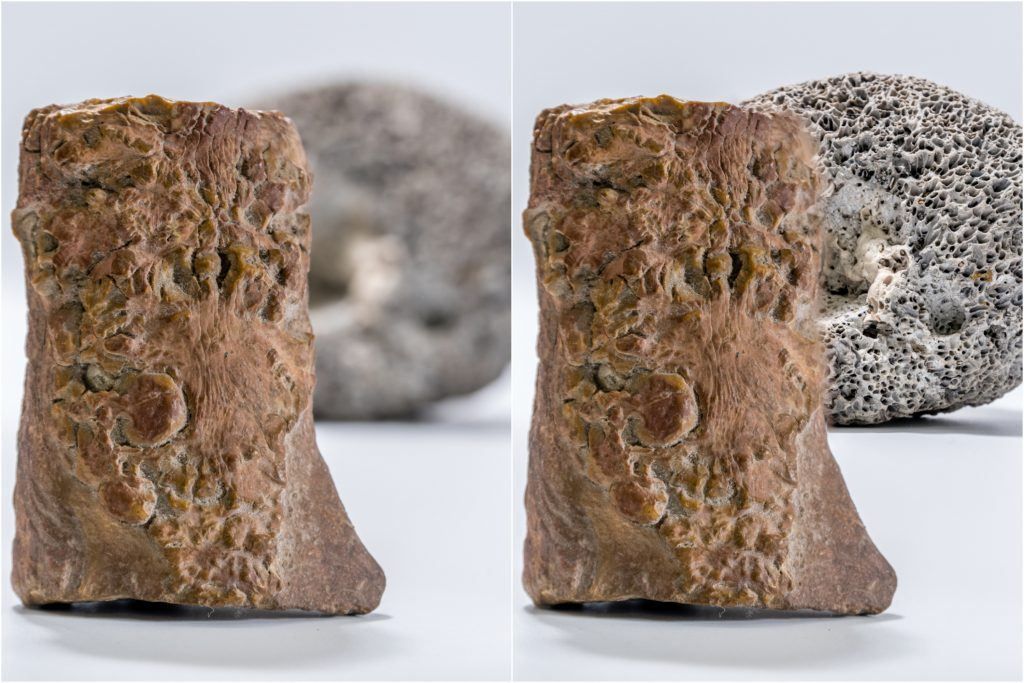

Examples of varying depths of field. Photo by Charles Haacker
DPI. Dots per inch, often used interchangeably with PPI (Pixels Per Inch). Higher DPI or PPI values show more detail. DPI is used in printing, and PPI in photography.
DSLR. Digital Single-Lens Reflex camera. Single-lens reflex cameras use an angled mirror to reflect the light coming in from the taking (single) lens, redirecting it through a prism or pentamirror to a viewfinder. They usually have interchangeable lenses and are distinct from Mirrorless (MILC) cameras.
Dynamic Range. The range of luminance of an image between its highest and lowest light intensities.
Exposure. The total amount of focused light striking the film or sensor, controlled by manipulating the Exposure Triangle.
Exposure Triangle/Triad. Shutter, Aperture, and ISO, the three variables of
correct Exposure.

Illustration by Charles Haacker
EV. Exposure Value. The EV system uses a simplified single number substituting for the shutter speed/aperture combination at a given ISO. One full EV is equivalent to a one-stop change when adjusting exposure compensation or bracketing.
Extension Tubes/Rings. Non-optical tubes (rings) made from metal or plastic
inserted between the lens and the camera, increasing the lens-to-sensor distance, allowing any lens of any focal length to focus closer than normal. “Poor Man’s Macro.”
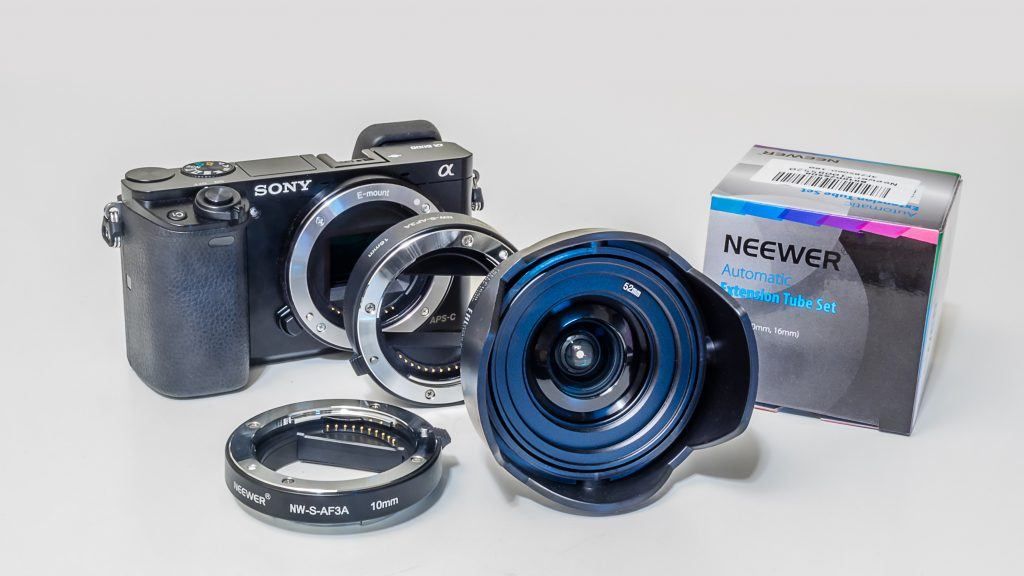
A set of extension rings (tubes) specific to the camera and fully automatic, making them very easy to use. Photo by Charles Haacker
The EV system uses a simplified single number substituting for the shutter speed/aperture combination at a given ISO.
Focal Length. The distance in millimeters (e.g. 28 mm, 50 mm, 100 mm) between the lens’s rear nodal point and the image sensor or film when the lens is focused at infinity. In the case of zoom lenses, both the minimum and maximum focal lengths are stated (e.g. 70–300mm).
FPS. Frames Per Second, the number of exposures a camera makes in burst mode, usually variable, as 5 FPS, 8 FPS, 12 FPS, or even higher depending on the camera.
F-Stop or f-Number. A number that indicates the physical area of the aperture or opening in your lens. Every aperture is expressed as an f-stop or f-number,
such as f/11 or f/2.8.
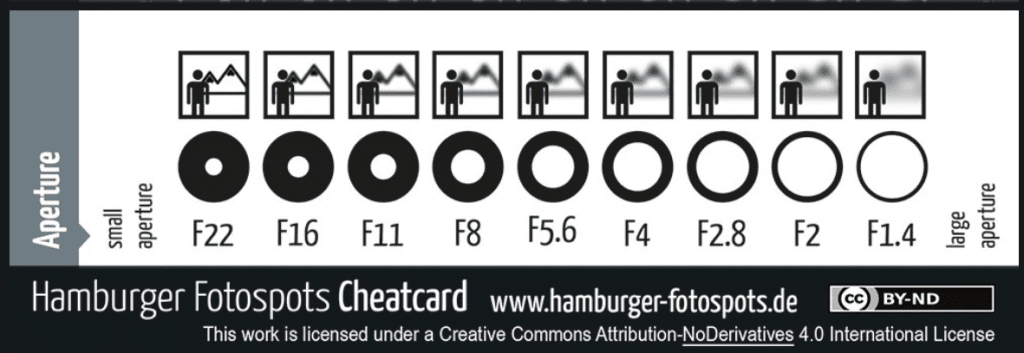
Graphic by Hamburger Fotospots licensed under CC
G. Glass, shorthand for lens. “That Zeiss is one gnarly hunk of glass!” (“That Zeiss lens is great.”) (All the really cool photographers talk like that.)
Golden Hour. Considered to be the hour before the sun goes down, plus 15 minutes. The light is usually very warm and complements skin tones. There is a comparable hour just at and after sunrise. “Photographers’ light.”
HDR. High Dynamic Range; a technique for capturing a wider range of proper exposure with detail from deep shadow to bright highlight than may be possible from a single exposure. Usually accomplished by bracketing exposures, then combining three or more into an HDR using an application like Photoshop. Works best on a tripod with static subjects like architecture or landscape.
Histogram. A bar chart graph that shows all of the tones in a digital image. A bell-curve histogram shows proper exposure, with the mid-tones humped in the center and the darkest and lightest values down at each end. Many cameras can display a histogram in the finder to aid in determining correct exposure. Most editing programs will generate a histogram that is very useful to the worker.
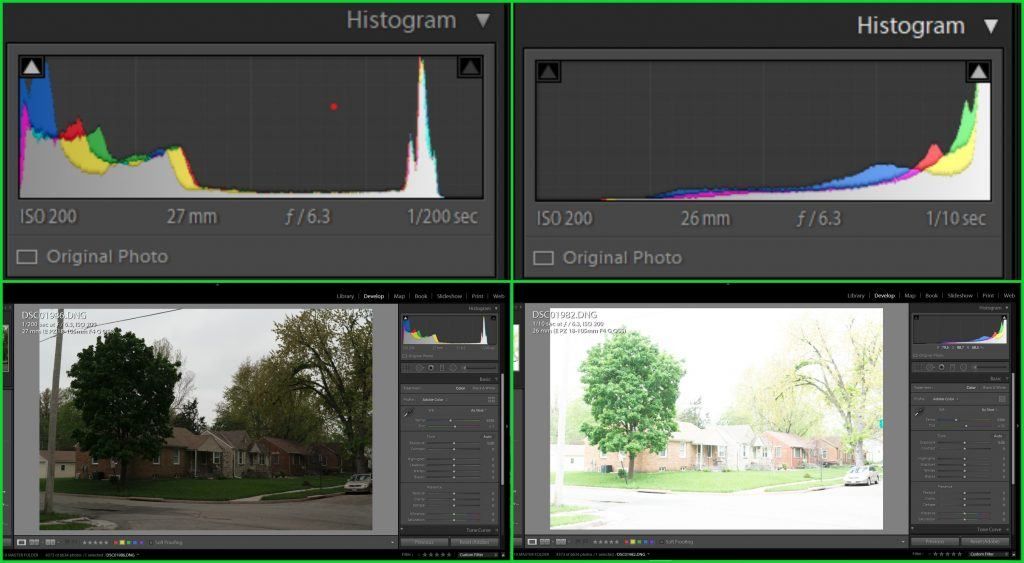
Histograms of underexposed and overexposed files in Lightroom. The shutter speeds tell you what went wrong. There is a 4-½ stop difference between exposures. Photo by Charles Haacker
Hyperfocal. Hyperfocal distance is a technique for setting a lens to make apparently sharp pictures within a certain distance range by manipulating the depth of field. The purpose is to get a sharp picture from near to far, even infinity, without refocusing.
Infinity. Infinity focus places the plane of critical focus sufficiently far away that rays of light reaching the lens from that plane are considered parallel. For practical purposes with a normal lens, infinity may be considered as around 40 feet (12 meters), but infinity moves further away the longer the focal length.
IS. Image Stabilization (a.k.a. shake reduction, SR, VR, VC – names various manufacturers use). Enables you to get sharper images hand-held at longer shutter speeds, or in dark conditions, or at longer focal lengths. Some IS is in the lens, some in the body, some in both. It generally gains you at least one EV over an unstabilized camera or lens. It’s important to turn it OFF when on a tripod or it will “hunt” for shake that’s not there and induce it.
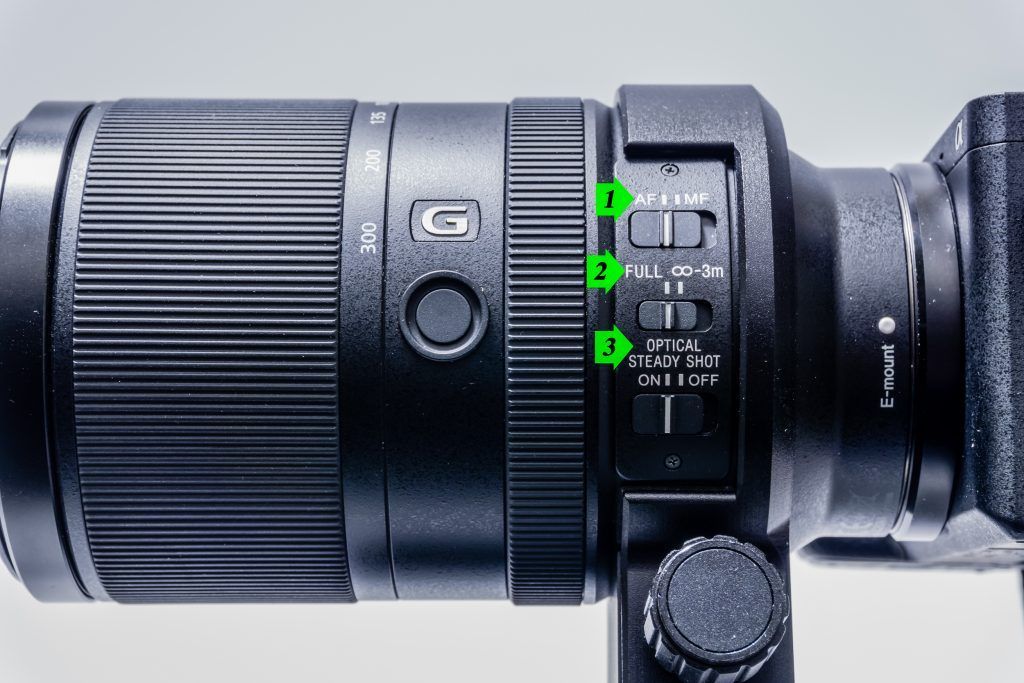
This lens’s Optical Steady Shot (#3) is ON. This lens has its controls on the barrel rather than in the menu. Photo by Charles Haacker
Iris Diaphragm. The variable aperture within the lens that controls the area of the opening (f/stop).
ISO. International Standards Organization. In film, ISO (formerly ASA) is a number representing the sensitivity to light of the film. In digital photography ISO measures the relative sensitivity of the camera sensor and can be adjusted in-camera. Film determines the ISO/ASA and locks it for the whole roll; digital allows us to vary the ISO frame by frame if we choose. The higher the number, the greater or “faster” the sensitivity.
JPEG/JPG. (From Joint Photographic Experts Group) is the most common image file format saved by digital cameras, as opposed to RAW. JPEGs are “lossily” compressed from the raw sensor data, losing some quality.
Kelvin. The visible light spectrum in terms of color temperature. Measured in degrees Kelvin (°K), named for Lord Kelvin (1824-1907) who devised the Kelvin absolute temperature scale. Noon daylight is usually around 5000°K. Household incandescent or equivalent is much yellower at around 2800°K.
Light. Visible electromagnetic energy that makes it possible to see and photograph things. Light visible to the human eye lies on a fairly narrow band of wavelengths, allowing us to see the colors red, orange, yellow, green, blue, indigo, and violet. Colors we cannot see but can photograph include infrared and ultraviolet.
Light Meter. A photosensitive instrument for measuring the intensity of light
reflected from or falling on a scene. Also called an exposure meter because it is most often used to determine correct exposure. Your camera has a light meter
that measures light reflected from the scene.
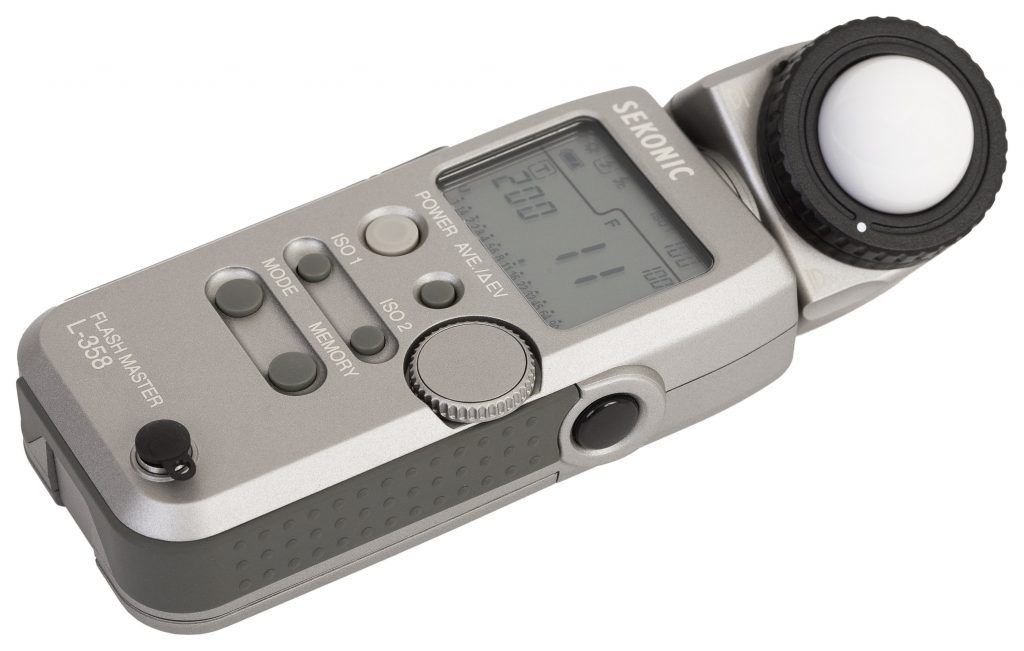
This hand-held light/exposure meter can accurately measure even high-speed strobes. Photo by Charles Lanteigne
Recommended Reading: Want a simple way to learn and master photography on the go? Grab our set of 44 printable Snap Cards for reference when you’re out shooting. They cover camera settings, camera techniques, and so much more. Check it out here.
Luminance. The intensity or brightness of a light source or of the light in a scene. Pure white has maximum brightness; pure black the minimum.
Macro. Extreme close-up photography at a ratio of 1:1, life-size on the film or
sensor, or even greater.
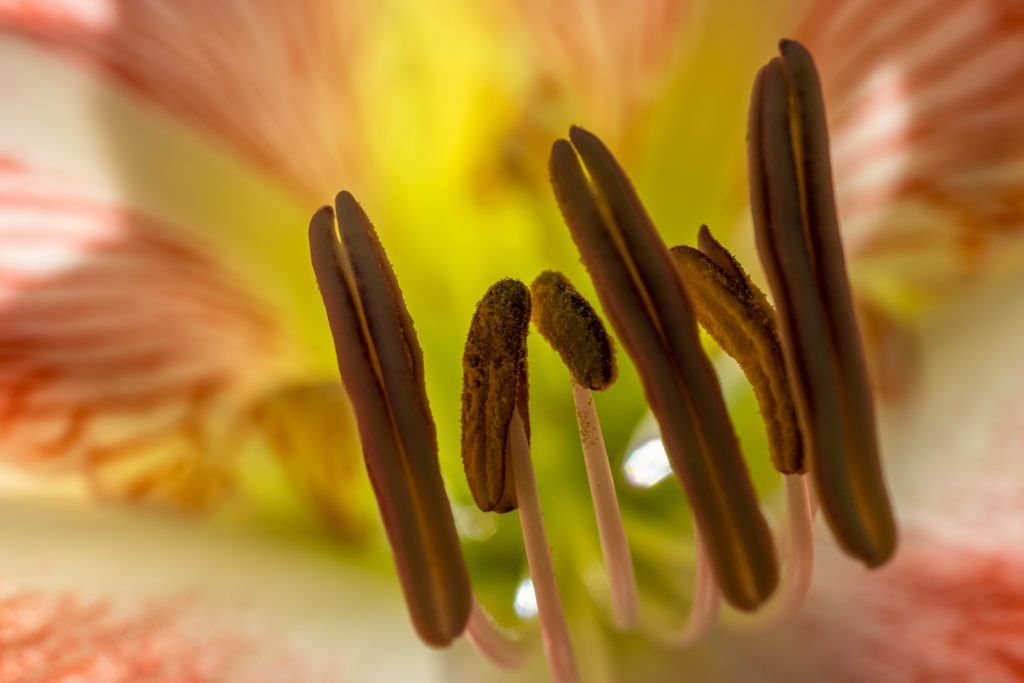
An example of macro photography, the anthers of the flower are greater than life-size. Photo by Charles Haacker
M. Manual Mode, the opposite of A-Automatic. When shooting in Manual, you take total control over every setting on your camera: aperture, shutter speed, ISO, white balance, metering, and even focus, if you choose.
Modes. Automatic systems pre programmed for taking photographs of common subjects such as action, portrait, landscape, night portrait, panorama, and more, but strictly output JPEGs.
Metadata. Non-image forming data embedded within image files describing the image. The information may include camera model, lens, exposure settings, and more.
When shooting in Manual, you take total control over every setting on your camera.. if you choose.
Megapixel. One million pixels; an area measurement like square feet. Used as a measure of resolution.
M4/3. Short for Micro Four-Thirds, also known as MFT. A mirrorless digital interchangeable lens system (MILC) developed by Olympus. Its sensor is smaller than APS-C (“half-frame”) but larger than 1”.
Neutral Density. A filter for use over the lens that absorbs all visible wavelengths equally. ND filters can be used with digital and color films since they have no effect on color balance. They are used to make longer exposures than would otherwise be possible, like for “silky” moving water.
Noise. Often referred to as digital grain, noise looks like tiny colored specks on a photo. It is especially visible in images shot at high ISO or very slow shutter speeds. Noise is actually an unwanted signal-to-noise ratio.
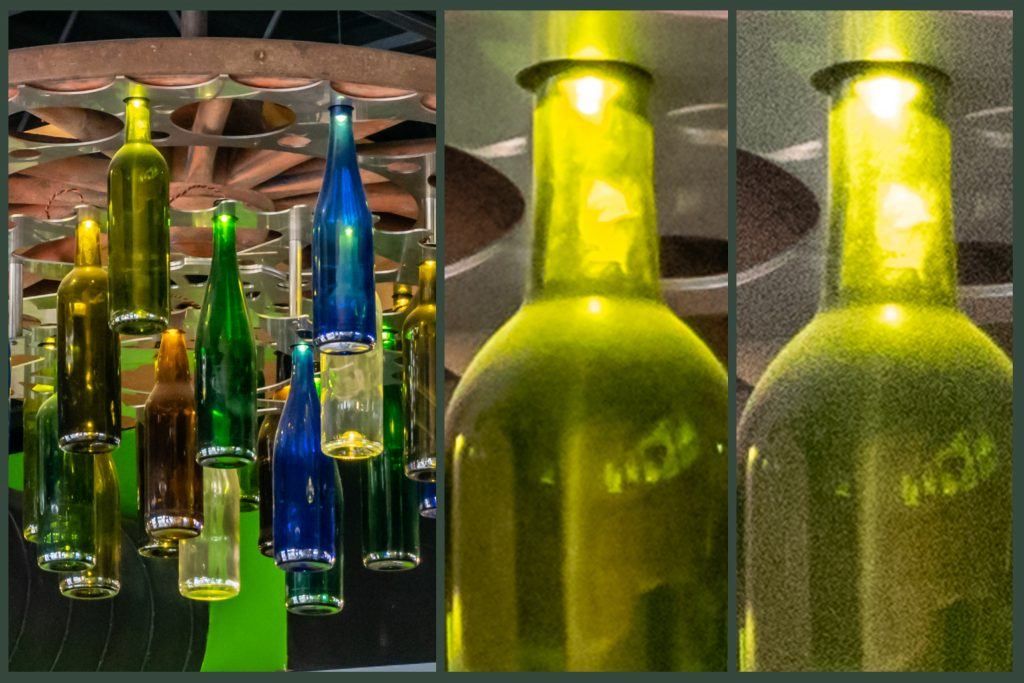
The picture was shot by available light at a high ISO of 6400. It looks fine at normal magnification, and not too bad after noise suppression in post production, but on the right, you can see the unsuppressed noise. Photo by Charles Haacker
Overexposure. When a picture is overall very light, with little or no detail in the
brightest highlights.
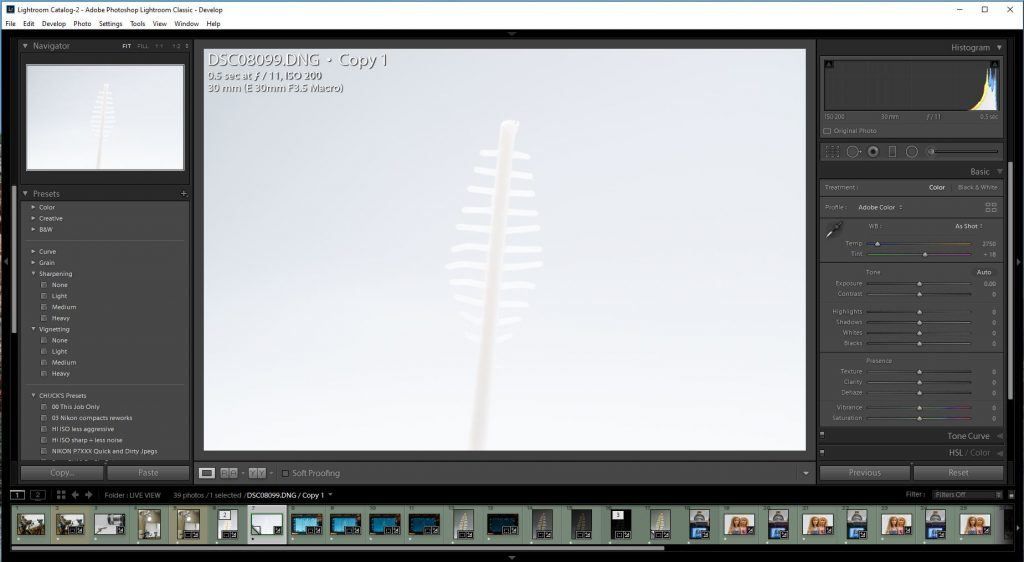
An example of overexposure. Look at the histogram at upper right, all crowded to the right. Photo by Charles Haacker
P. Program Mode, an automatic shooting mode where the camera adjusts both
aperture and shutter speed automatically, while allowing you to adjust ISO. Useful when you need to quickly adjust either shutter or aperture while the camera instantly compensates the other to keep the same exposure. Gives finer control than A- Automatic mode.
Panning. The technique of taking a picture while tracking motion at a relatively slow shutter speed. The moving object appears more-or-less sharp while its surroundings are blurred. It illustrates or implies motion.
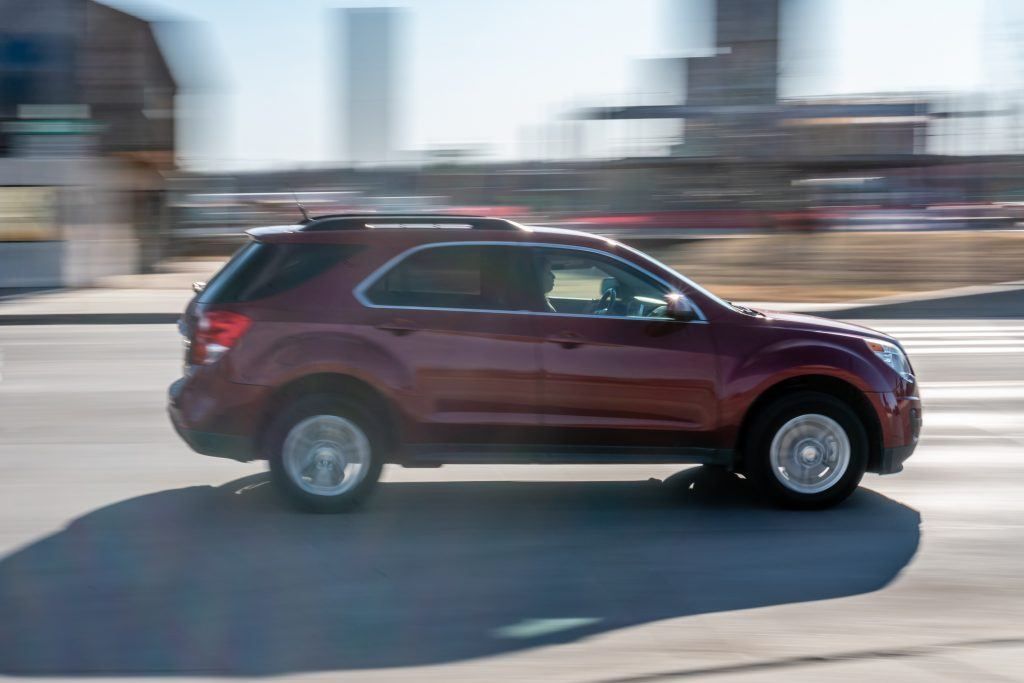
Panning with a fast car at 1/40 of a second. Photo by Charles Haacker
P&S. Point and Shoot; any camera in full automatic mode. Generally, this refers to small-sensor pocketable cameras with few to no user controls – just automatic and scene modes – but any camera that has a total auto mode can be used like a P&S.
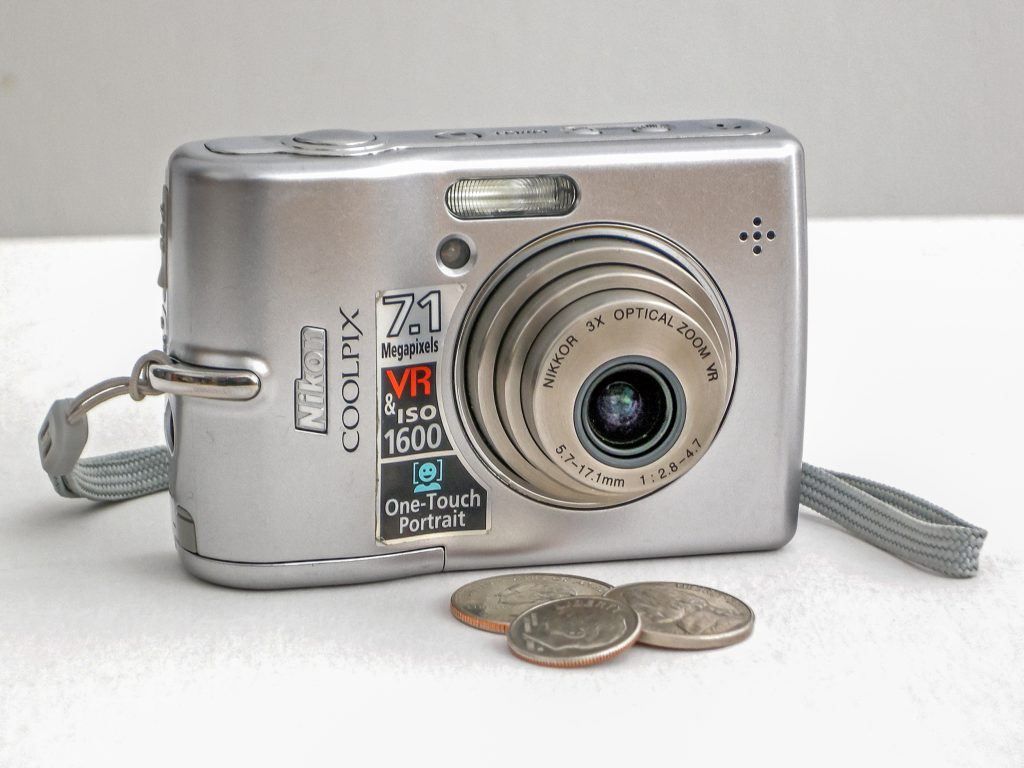
A 2007 Nikon L12, a $100 point-and-shoot no bigger than a pack of cards. Photo by Charles Haacker
Pixel. Abbreviation for “picture element,” the smallest unit in a digital image. A small square of colored light that forms a digital image as a mosaic.
Post. Short for post-processing in apps such as Lightroom, Gimp, and Adobe Camera Raw.
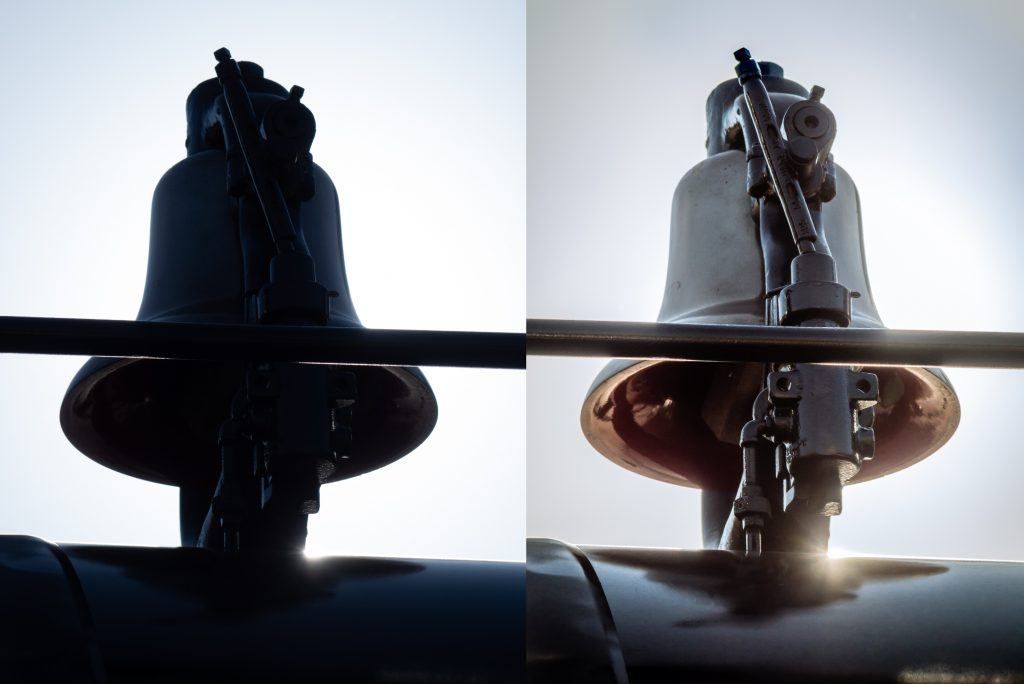
A RAW capture before and after post-processing in Lightroom. Photo by Charles Haacker
Prime. A fixed focal length lens as opposed to a zoom lens. Primes are often considered sharper and faster than zooms or varifocals, plus they are lighter and more compact.
Quality. Image Quality (IQ), generally. A well-photographed and well-processed picture that is sharp, with accurate color, good composition, and other excellent characteristics.
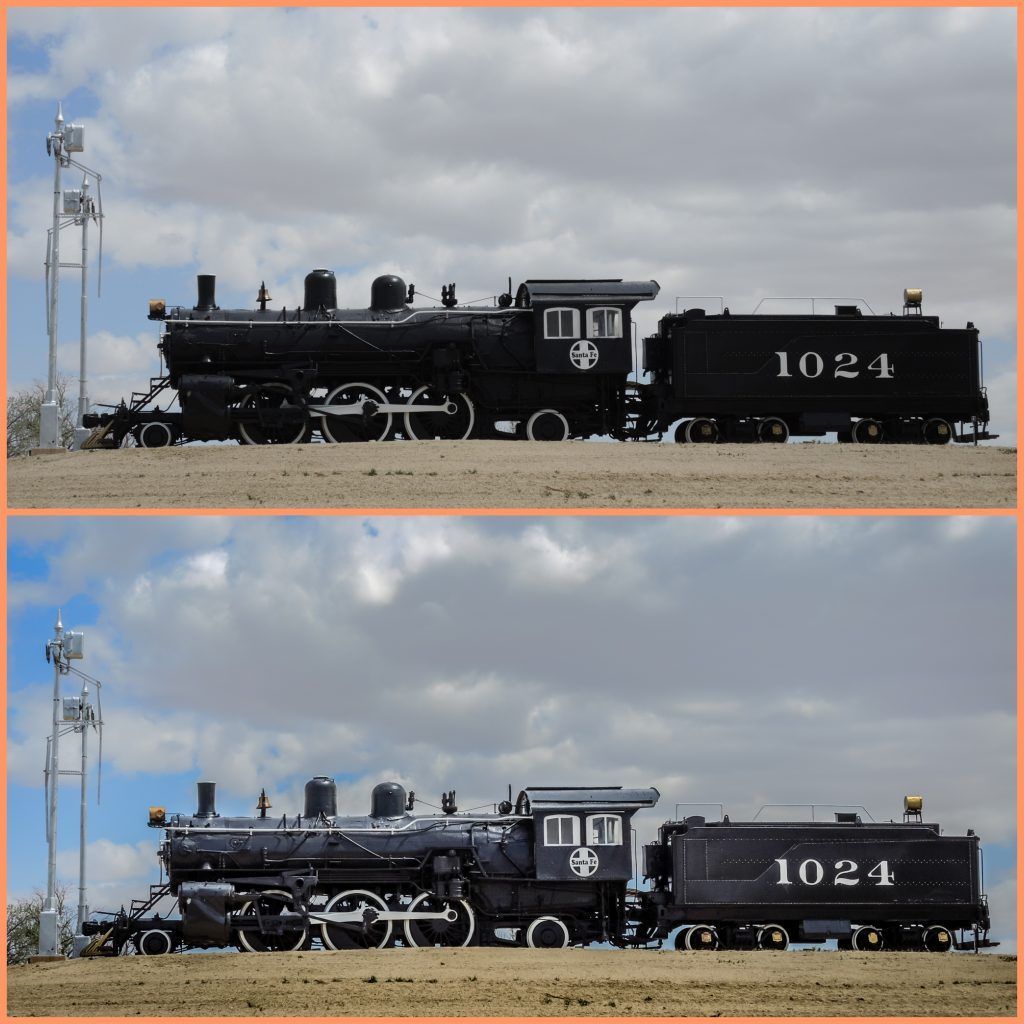
The original picture at the top lacks Image Quality, but after post-processing the IQ is much improved. Photo by Charles Haacker
RAW. RAW format, or just RAW. Not an acronym but rather all of the raw, unprocessed, uncompressed data captured by the camera sensor. It’s often described as analogous to a film negative. RAW files are many times superior to JPEGs but they must be post-processed or there is no image.
Resolution. The fine detail in an image. In digital it refers to the number of pixels that fit into a given area, given as Pixels Per Inch (PPI). Digital resolution is also given in megapixels = 1 million pixels.
RGB. RGB stands for Red, Green, and Blue, the additive color primaries for viewing imagery on digital displays (see also CMYK).
Shutter. Controls the length of TIME that light is allowed to pass through the lens to reach the film/image sensor. Shutters are composed of blades, a curtain, a plate or other movable device. (See also APERTURE.)
S. Shutter Priority Mode (sometimes TV, Time Value); an automatic setting where you set the shutter speed while the camera automatically adjusts the aperture for proper exposure. Good for shooting moving subjects. It prioritizes speed over depth of field. Good for panning.
Saturation. The degree of intensity of color in an image. Saturated color can be strong, rich, vivid, in-tense, or deep. Desaturated color can be weak, pale, washed out, or dull. An oversaturated image’s colors are too intense. (See also Vibrance.)

The original RAW capture was weak and flat. After processing, its vibrance and saturation were much improved. Photo by Charles Haacker
Scene Mode. Fully automatic camera modes with preset exposure values based on different types of situations and subjects. Produces JPEGs only.
SLR. Single Lens Reflex; any camera using a mirror to divert the image-forming light from the taking lens to a viewfinder (see DSLR) (see TLR).
TIFF. Tagged Image File Format, a lossless, uncompressed file format for digital images that does not lose color and detail.
Tonal Range. The range between the lightest and darkest areas of an image, also called dynamic range. A picture with very bright and very dark areas has a wide tonal range, which may be outside the ability of the sensor to hold detail on both ends.
TLR. Twin Lens Reflex, a camera with two lenses and a mirror that diverts an image from the upper viewing lens to a viewfinder. The TLR was very popular once but suffered from parallax because the viewing lens was not the taking lens.
TTL. Through the Lens, refers to the automatic metering system which is reading through the taking lens. Many shoe-mounted speedlights, flashes dedicated to a particular camera, can be TTL, yielding astonishingly accurate flash exposures without resorting to head-scratching kitchen arithmetic.
Underexposure. Usually means that the exposure value was too low, resulting in a photo that may be too dark to produce normal contrast.
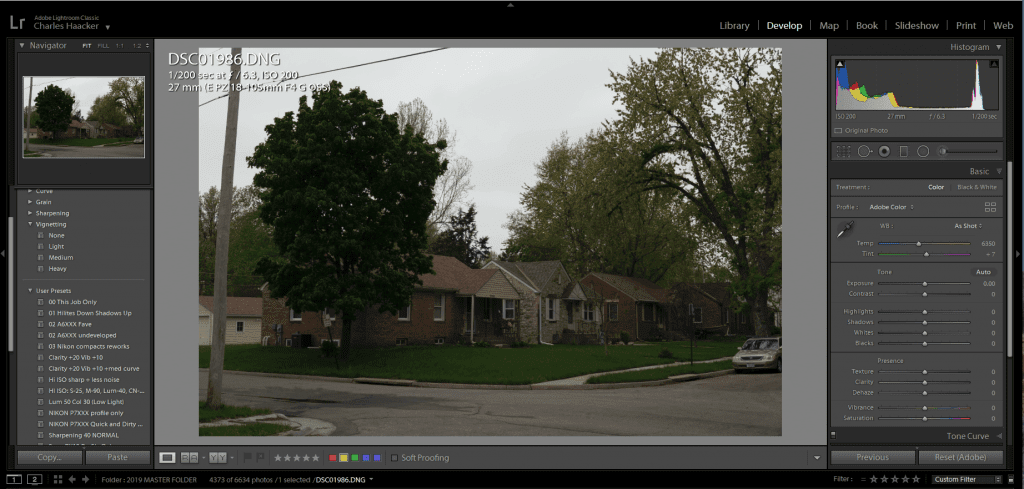
An underexposed RAW image file before processing. Photo by Charles Haacker
Varifocal. A camera lens with variable focal length in which focus changes as focal length and magnification vary, as compared to parfocal (“true”) zoom lenses, which remain in focus as the lens zooms. Varifocals focus and zoom internally; parfocals may change their physical length when zooming.
Vibrance. A post-processing term coined by Adobe to describe a “smart” saturation setting. Vibrance affects only colors that are not already fully saturated to avoid oversaturation.
Vignetting. When the corners of a picture are faded or cut off. Using a lens formulated for a crop sensor on a full-frame camera will cause dark vignetting at the corners because the image circle is smaller than the sensor. Using the wrong lens hood can cause dark vignetting. In post-processing, light or dark vignettes can be created as an artistic device.
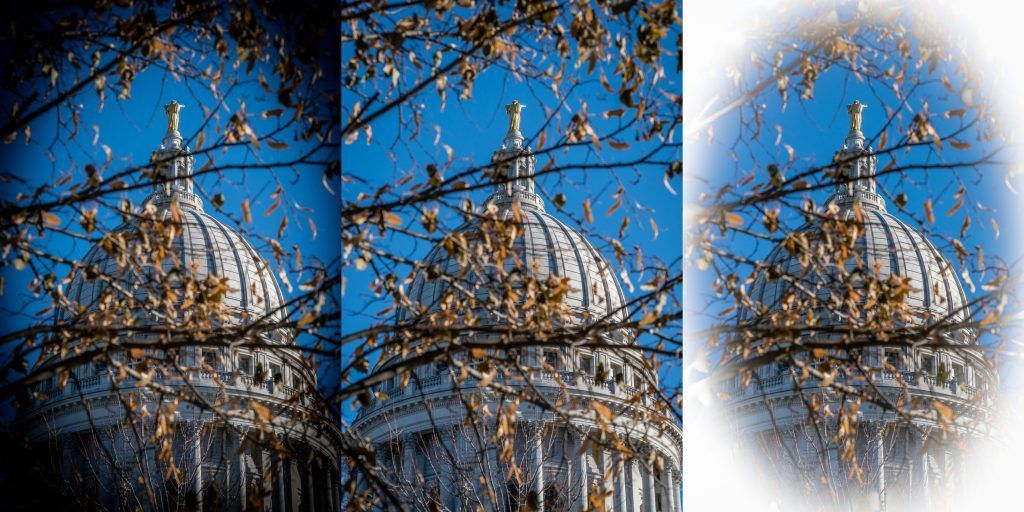
Examples of badly overdone vignettes in post-processing. The center picture is correct. Photo by Charles Haacker
Using the wrong lens hood can cause dark vignetting.
WB. White Balance. “White” light has long been defined as noon sunlight. “Daylight” films are balanced for it but give strange colors in artificial light. Digital can be specifically balanced for nearly any light. You can choose from a menu, you can use a Kelvin scale, or you can “shoot” a custom white balance from a gray card or a neutral wall. If you shoot in RAW, white balance can be fine-tuned or completely changed in post-production.
X-Sync or Setting. Instant synchronization of electronic flash with the shutter.The flash fires at the instant the shutter is fully open. Electronic flashes produce a very short flash so the entire frame is fully exposed before the shutter can close.
Yellow Filter. A pale-yellow filter (Wratten 8) was commonly used in black and white photography because yellow absorbs blue, causing a subtle increase in contrast in a blue sky. Monochrome photographers usually carried an assortment of filters in different colors and densities to modify tonal values.
Zoom Lens. A parfocal camera lens with variable focal length which remains in focus as the lens zooms, as opposed to varifocal lenses where the focus changes as the focal length changes. Varifocals focus and zoom internally; parfocals often change their physical length when zooming. (See also Varifocal.)
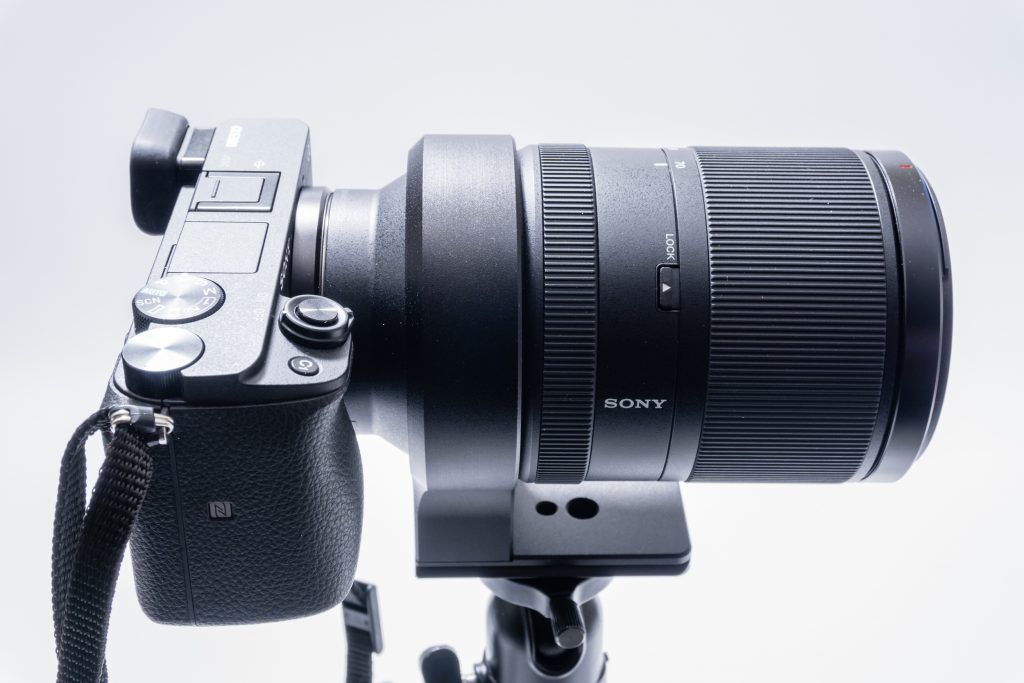
A massive 70-300mm zoom lens. On a crop sensor this lens mimics a 105-450mm. Photo by Charles Haacker
Recommended Reading: Want a simple way to learn and master photography on the go? Grab our set of 44 printable Snap Cards for reference when you’re out shooting. They cover camera settings, camera techniques, and so much more. Check it out here.
Conclusion
There are many, many glossaries of photographic terms. I have taken my cue from some of them, seeking out the stuff I think is most relevant but often most obscure, like °KELVIN. I chose many because I use them all the time without thinking, but if you don’t know the lingo, I will inadvertently confuse you. The main thing is, like any other profession or hobby, photography has its own unique jargon, so when you come across an artifact, it helps to know that you’re talking to a photographer, not an archaeologist.
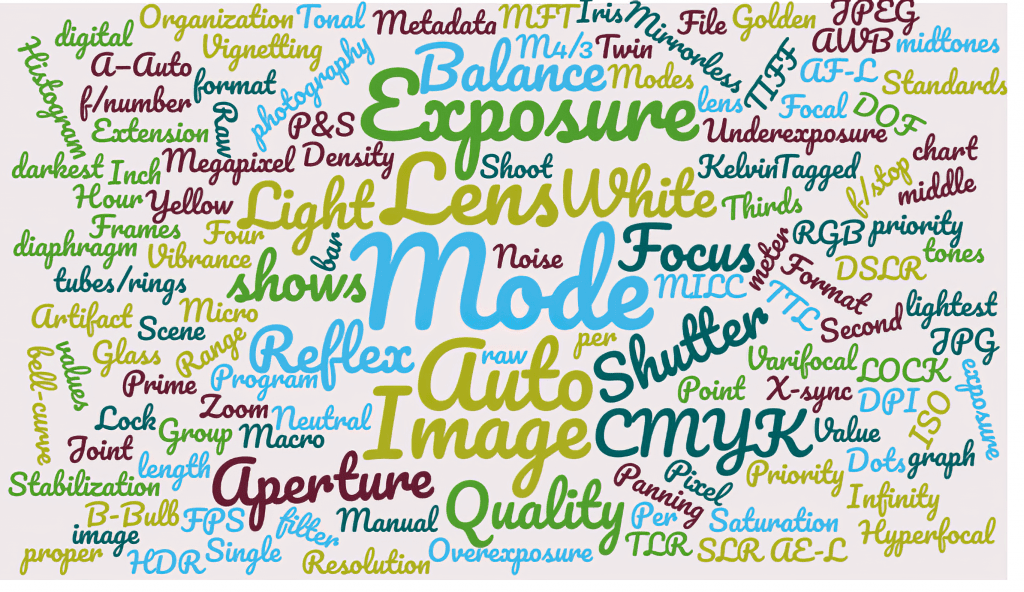
Illustration by Charles Haacker
Self-Check Quiz:
- What does MILC stand for?
- What does FPS refer to?
- What is “Post” shorthand for?
- What does IQ in photography refer to?
- True or False: EV is the same as an f/stop or a shutter speed.
- True or False: TLR is an acronym for a photographic chemical.
- True or False: The letter P on your command dial stands for Professional.
- True or False: ISO is not a leg of the exposure triad.
- True or False: Bob and Ray are characters in a deeply existential play about nothing.

